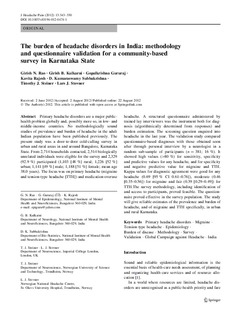| dc.contributor.author | Rao, GN | |
| dc.contributor.author | Kulkarni, GB | |
| dc.contributor.author | Gururaj, Gopalakrishna | |
| dc.contributor.author | Rajesh, K | |
| dc.contributor.author | Subbakrishna, DK | |
| dc.contributor.author | Steiner, Timothy J. | |
| dc.contributor.author | Stovner, Lars Jacob | |
| dc.date.accessioned | 2019-10-16T15:57:30Z | |
| dc.date.available | 2019-10-16T15:57:30Z | |
| dc.date.created | 2012-11-20T13:15:13Z | |
| dc.date.issued | 2012 | |
| dc.identifier.citation | The Journal of Headache and Pain. 2012, 13 (7), 543-550. | nb_NO |
| dc.identifier.issn | 1129-2369 | |
| dc.identifier.uri | http://hdl.handle.net/11250/2622662 | |
| dc.description.abstract | Primary headache disorders are a major public-health problem globally and, possibly more so, in low- and middle-income countries. No methodologically sound studies of prevalence and burden of headache in the adult Indian population have been published previously. The present study was a door-to-door cold-calling survey in urban and rural areas in and around Bangalore, Karnataka State. From 2,714 households contacted, 2,514 biologically unrelated individuals were eligible for the survey and 2,329 (92.9 %) participated (1,103 [48 %] rural; 1,226 [52 %] urban; 1,141 [49 %] male; 1,188 [51 %] female; mean age 38.0 years). The focus was on primary headache (migraine and tension-type headache [TTH]) and medication-overuse headache. A structured questionnaire administered by trained lay interviewers was the instrument both for diagnosis (algorithmically determined from responses) and burden estimation. The screening question enquired into headache in the last year. The validation study compared questionnaire-based diagnoses with those obtained soon after through personal interview by a neurologist in a random sub-sample of participants (n = 381; 16 %). It showed high values (>80 %) for sensitivity, specificity and predictive values for any headache, and for specificity and negative predictive value for migraine and TTH. Kappa values for diagnostic agreement were good for any headache (0.69 [95 % CI 0.61–0.76]), moderate (0.46 [0.35–0.56]) for migraine and fair (0.39 [0.29–0.49]) for TTH.The survey methodology, including identification of and access to participants, proved feasible. The questionnaire proved effective in the survey population. The study will give reliable estimates of the prevalence and burden of headache, and of migraine and TTH specifically, in urban and rural Karnataka. | nb_NO |
| dc.language.iso | eng | nb_NO |
| dc.publisher | BMC (part of Springer Nature) | nb_NO |
| dc.rights | Navngivelse 4.0 Internasjonal | * |
| dc.rights.uri | http://creativecommons.org/licenses/by/4.0/deed.no | * |
| dc.title | The burden of headache disorders in India: methodology and questionnaire validation for a community-based survey in Karnataka State | nb_NO |
| dc.type | Journal article | nb_NO |
| dc.type | Peer reviewed | nb_NO |
| dc.description.version | publishedVersion | nb_NO |
| dc.source.pagenumber | 543-550 | nb_NO |
| dc.source.volume | 13 | nb_NO |
| dc.source.journal | The Journal of Headache and Pain | nb_NO |
| dc.source.issue | 7 | nb_NO |
| dc.identifier.doi | 10.1007/s10194-012-0474-1 | |
| dc.identifier.cristin | 963607 | |
| dc.description.localcode | This article is distributed under the terms of the Creative Commons Attribution 2.0 International License (https://creativecommons.org/licenses/by/2.0), | nb_NO |
| cristin.unitcode | 194,65,30,0 | |
| cristin.unitcode | 1920,16,0,0 | |
| cristin.unitname | Institutt for nevromedisin og bevegelsesvitenskap | |
| cristin.unitname | Nevroklinikken | |
| cristin.ispublished | true | |
| cristin.fulltext | original | |
| cristin.qualitycode | 1 | |

